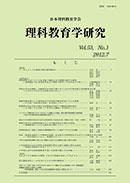Volume 52, Issue 2
Displaying 1-17 of 17 articles from this issue
- |<
- <
- 1
- >
- >|
Original Papers
-
2011Volume 52Issue 2 Pages 1-9
Published: November 01, 2011
Released on J-STAGE: July 10, 2021
Download PDF (5231K) -
2011Volume 52Issue 2 Pages 11-21
Published: November 01, 2011
Released on J-STAGE: July 10, 2021
Download PDF (6869K) -
2011Volume 52Issue 2 Pages 23-32
Published: November 01, 2011
Released on J-STAGE: July 10, 2021
Download PDF (5634K) -
2011Volume 52Issue 2 Pages 33-45
Published: November 01, 2011
Released on J-STAGE: July 10, 2021
Download PDF (7417K) -
2011Volume 52Issue 2 Pages 47-54
Published: November 01, 2011
Released on J-STAGE: July 10, 2021
Download PDF (4879K) -
2011Volume 52Issue 2 Pages 55-64
Published: November 01, 2011
Released on J-STAGE: July 10, 2021
Download PDF (5845K) -
2011Volume 52Issue 2 Pages 65-73
Published: November 01, 2011
Released on J-STAGE: July 10, 2021
Download PDF (5271K) -
2011Volume 52Issue 2 Pages 75-84
Published: November 01, 2011
Released on J-STAGE: July 10, 2021
Download PDF (5365K) -
2011Volume 52Issue 2 Pages 85-93
Published: November 01, 2011
Released on J-STAGE: July 10, 2021
Download PDF (5003K) -
2011Volume 52Issue 2 Pages 95-103
Published: November 01, 2011
Released on J-STAGE: July 10, 2021
Download PDF (4965K) -
2011Volume 52Issue 2 Pages 105-114
Published: November 01, 2011
Released on J-STAGE: July 10, 2021
Download PDF (5782K) -
2011Volume 52Issue 2 Pages 115-122
Published: November 01, 2011
Released on J-STAGE: July 10, 2021
Download PDF (4465K) -
2011Volume 52Issue 2 Pages 123-130
Published: November 01, 2011
Released on J-STAGE: July 10, 2021
Download PDF (4318K) -
2011Volume 52Issue 2 Pages 131-141
Published: November 01, 2011
Released on J-STAGE: July 10, 2021
Download PDF (6532K) -
2011Volume 52Issue 2 Pages 143-153
Published: November 01, 2011
Released on J-STAGE: July 10, 2021
Download PDF (7015K) -
2011Volume 52Issue 2 Pages 155-169
Published: November 01, 2011
Released on J-STAGE: July 10, 2021
Download PDF (9181K)
Note
-
2011Volume 52Issue 2 Pages 171-177
Published: November 01, 2011
Released on J-STAGE: July 10, 2021
Download PDF (4066K)
- |<
- <
- 1
- >
- >|
